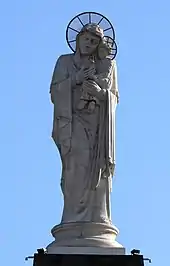Golemantsi
Golemantsi (Turkish: Beyköy) is a village in the municipality of Haskovo, in Haskovo Province, in southern Bulgaria,[1]
Golemantsi
Beyköy | |
|---|---|
Village | |
| Country | |
| Province | Haskovo Province |
| Municipality | Haskovo |
| Time zone | UTC+2 (EET) |
| • Summer (DST) | UTC+3 (EEST) |
History
The name of the village was Beyköy, founded around 1504 - 1505, named after his founder, a Koçi Bey. This village once belonged to the Hasköylü Ağalık, (Agaluk of Haskovo), once ruled by a local Ottoman Agha family. The majority of the inhabitants of Golemantsi are Bulgarian Turks, the minority of Thracian Bulgarians settlers came around 1924–25. The majority of the Turkish inhabitants are of Bektashi Order the other's belong to Sunni Islam. There are a Mosque, Hamam and three Tekke of Bektashi Babalar: Hasan Dede, Muharrem Rıza Yusuf and Sadullah Sadık.
Also Kadriye Latifova a Turkish singer was born in this Village.
Nasuh Pasha
One of the leading local figures in the Haskovo region, was Hasköylü Nasuh Paşa. He was born around the 1850s in Beyköy (Golemantsi), into a poor family of Bulgarian Turks, whose Ancestor's once came centuries before from the Karaduraklı village of Kırşehir Province, and belongend to the Karakoç clan of Bayat (tribe). He lost his parents early and grew up as an orphan. In young age he tended sheep for the rich Haskovo Çorbacısı Boyacıoğlu Ağa, however, he managed to become a wealthy Landowner and was called Pasha. He married four wifes, including the daughter of the Haskovo Çorbacısı Boyacıoğlu Ağa, named Büyük Hanım (Great Lady). He bought several lands at the Haskovo Municipality, but he also had a (Köşk) (Mansion) in Edirne, where part of his family lived there. In Haskovo City, he and his family lived in the main residence, the Boyacıoğlu house. In Beyköy (Golemantsi), he built a large Konak (residence), with a Haremlik and Selamlik and a big Animal stall, which unfortunately later was destroyed by fire at the Balkan War (1912-13). He ruled this Turkish exclave at the Eastern Rhodope Mountains de facto independent from 1885 until 1913. Since 1889 he was one of the first Breeder of Karakul sheep in Bulgaria. He used the proceeds to provide for poor families, and was a great promoter of Turkish Oil wrestling. Many of Nasuh Pasha's male offspring have been and are Kırkpınar. He held a major Khitan (circumcision) ceremony for his sons and later for his grandsons. On the occasion of the exhibition fair in Plovdiv in 1892, he was awarded with the Order for Civil Merit. He had two son's Mehmet Ali Bey and Ahmet Bey, as well as a daughter named Paşa Kızı (Pasha's daughter). During the Balkan War (1912-13), Nasuh Pasha, lost all his possessions in Bulgaria, and about the Siege of Adrianople (1912–1913), he lost also his (Köşk) (Mansion) in Edirne, and the family became very poor. His oldest son Mehmet Ali Bey, his daughter in-law Fehime Hanım and his Grandchildren Hüseyin Bey, Mustafa Bey, Nemzâde Hanım, and his youngest son Ahmet Bey, fled from Haskovo to Istanbul as Muhacir. Nasuh Pasha already lived with his daughter in Edirne even before the time of the Balkan War (1912-13); his daughter met and fell in love with an American businessman, and left the Ottoman Empire. Around 1929-30 the whole Family left Istanbul and settled in Babaeski and Ahmet's descendants intermarried with the Pomaks in Turkey, and live in Büyükmandıra as Farmers. Nasuh Pasha's Grandson's Hüseyin and Mustafa's descendants intermarried with the Bulgarian Turks in Turkey. Nasuh's Granddaughter Nemzâde was taken away in Bride kidnapping, by Şaban, a Muslim Roma of the big Romani Sarmaşık family clan of Kırklareli Province, their descendants intermarried again with the Romani people in Turkey. Some of Nasuh Pasha's descendants came to Germany as Gastarbeiter, one of his great-grandson's of the Romani branch, married a German woman of Danube Swabians Background.
